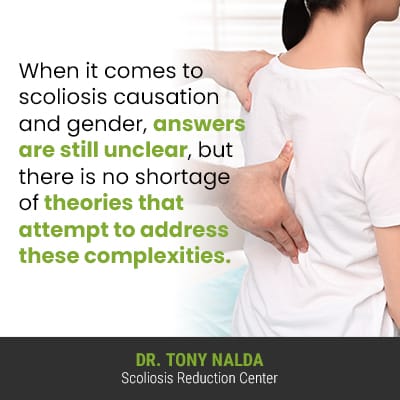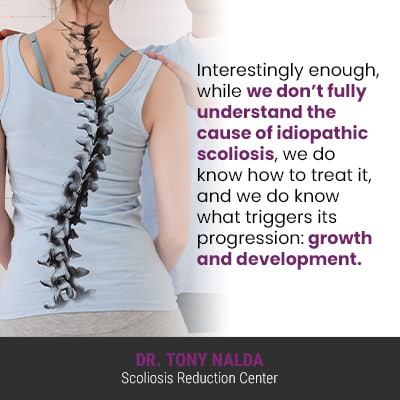Why is Scoliosis More Common in Females?

Scoliosis doesn’t just range widely in severity from mild to very severe, there are also multiple condition types, and scoliosis affects all ages. In addition, the spinal condition is more frequently diagnosed in females than in males; continue reading to explore theories regarding the higher prevalence in females.
Adolescent idiopathic scoliosis is the condition’s most prevalent form, and not only are females diagnosed more frequently, they are also more likely to experience progression than males; theories addressing this range from an earlier initiation into puberty to hormones and body mass index.
Before getting to theories attempting to explain the higher prevalence of scoliosis in females, let’s first explore how scoliosis is first diagnosed.
Table of Contents
Diagnosing Scoliosis
The spine’s healthy and natural curves make it stronger, more flexible, and better able to handle mechanical stress incurred during activity.
In a spine with its natural curves in place, the vertebrae (bones of the spine) are aligned in a straight and neutral position, and this is necessary for the spine to function as it was designed.
If the spine loses one or more of its healthy curves, the biomechanics of the entire spine are disrupted, and this can cause a number of problems and effects felt throughout the body.
After all, the spine doesn’t just allow us to stand upright, practice good posture, protect organs, and facilitate flexible movement, it also works in tandem with the brain to form the body’s central nervous system (CNS): a complex communication network that’s involved in the function of virtually every system at work within the body.
When scoliosis is diagnosed, an abnormal sideways spinal curvature has developed, and in addition to bending unnaturally to the side, a scoliotic spine also twists, making it a complex 3-dimensional structural spinal condition.
In addition, in order to be considered a true scoliosis, the unnatural spinal curve has to be of a minimum size: Cobb angle measurement of at least 10 degrees.
Condition Severity
A patient’s Cobb angle is measured during X-ray and tells me how far out of alignment the curve’s most-tilted vertebrae are.
Conditions are also classified based on severity, and the higher the Cobb angle, the more severe the condition:
- Mild scoliosis: Cobb angle measurement of between 10 and 25 degrees
- Moderate scoliosis: Cobb angle measurement of between 25 and 40 degrees
- Severe scoliosis: Cobb angle measurement of 40+ degrees
- Very-severe scoliosis: Cobb angle measurement of 80+ degrees
Scoliosis is also progressive, meaning it has it in its very nature to worsen over time, so the condition’s severity levels are also its progressive line, meaning where a scoliosis is at the time of diagnosis isn’t necessarily indicative of where it will stay.
Only proactive treatment can work towards counteracting the condition’s progressive nature.
When we move on to the different types of scoliosis, this is where we get into some further mysterious aspects of scoliosis, involving causation.
What Causes Scoliosis?
As mentioned, not only does scoliosis range so widely in severity, necessitating the customization of effective treatment plans, there are also different types of scoliosis, determined by their underlying cause.
Despite scoliosis being around for hundreds of years, and as highly prevalent a condition as it is, we still don’t fully understand it.
 When it comes to causation and gender, answers are still unclear, but there is no shortage of theories that attempt to address these complexities.
When it comes to causation and gender, answers are still unclear, but there is no shortage of theories that attempt to address these complexities.
The most common type of scoliosis to affect both adults and adolescents is idiopathic scoliosis, and idiopathic means we don’t fully know what triggers its initial onset, and the most prevalent type of scoliosis, overall, is adolescent idiopathic scoliosis (AIS), diagnosed between the ages of 10 and 18.
Idiopathic scoliosis accounts for approximately 80 percent of known diagnosed cases, and the remaining 20 percent are associated with known causes: neuromuscular scoliosis, degenerative scoliosis, and congenital scoliosis.
Why is Adolescent Idiopathic Scoliosis More Common in Females?
 Interestingly enough, while we don’t fully understand the cause of idiopathic scoliosis, we do know how to treat it, and we do know what triggers its progression: growth and development.
Interestingly enough, while we don’t fully understand the cause of idiopathic scoliosis, we do know how to treat it, and we do know what triggers its progression: growth and development.
When scoliosis is progressing, this means the unnatural spinal curve is increasing in size, introducing more and more uneven forces to the body, which cause more noticeable effects and symptoms.
Another interesting condition characteristic is that, according to the American Academy of Orthopaedic Surgeons, female adolescents are 10 times more likely to be diagnosed with adolescent idiopathic scoliosis prior to reaching the age of 10, than male adolescents are.
In addition, when a female is diagnosed with adolescent idiopathic scoliosis, their conditions are also approximately 10 times more likely to progress than in males of the same age.
So first of all, why are female adolescents diagnosed so much more frequently than males of the same age, and why is it that scoliosis in female adolescents is also more likely to get worse?
While there is no clear definitive theory to explain this, there are multiple theories that attempt to answer those questions, so let’s explore some of the most prevalent.
Early Initiation into Puberty
While there is no steadfast rule about when puberty starts in children, it does commonly start earlier in girls than in boys, and this is related to hormones.
Now, as the progressive trigger for scoliosis is growth and development, it’s thought that the earlier initiation into puberty, a stage characterized by rapid and unpredictable growth spurts, could account for the higher prevalence of scoliosis in female adolescents, than in males.
So if hormones start puberty earlier in female adolescents, this earlier initiation into puberty could account for the higher incidence of scoliosis in females, and what hormone(s) are we talking about?
Leptin
Leptin is considered a master hormone because of the many roles it plays in regulating growth, reproduction, and hunger.
Leptin is involved in bone growth, the initiation of puberty, body weight, and regulating the sympathetic nervous system (SNS).
One hormone-related theory is that the increased incidence of scoliosis in females is caused by leptin levels and how it impacts sympathetic nervous system activity.
There have been a number of studies that have found correlations between low body mass index (BMI) and higher rates of AIS, and it’s known that lower levels of leptin in females is connected to idiopathic scoliosis onset.
The theory posits that females who are more susceptible to AIS onset are those that have an altered sensitivity to leptin, known to stimulate sympathetic nervous system activity.
An increase in sympathetic nervous system activity can cause the following effects:
- Early maturation
- Increased rates of skeletal growth/reaching skeletal maturity earlier
- Increase height
- Asymmetries in skeletal length
- Lower body mass index
The uneven forces of scoliosis are known to disrupt the body’s overall symmetry, which is why the main symptom of scoliosis in adolescents is postural deviation; it’s been suggested that the function of the sympathetic nervous system dictates changes to the spine, like asymmetries, and this can complicate the process of spinal growth in adolescents.
These types of hormone-related factors, and the earlier initiation into puberty, are thought to also explain why girls tend to progress faster than boys, but whether this is more closely related to hormones, nervous-system activity, or a combination of both remains unclear.
Conclusion
Here at the Scoliosis Reduction Center, I’ve treated all types and severity levels of scoliosis, and while many of my patients are adolescent females, scoliosis affects all ages and genders.
While we don’t always understand why scoliosis develops, we most certainly know how to respond to its diagnosis: with proactive treatment.
Regardless of age or severity, as a progressive condition, the best time to start treatment is always now, particularly in patients who have not yet reached skeletal maturity; growth and development are known to trigger the condition’s progression.
In the most prevalent type of scoliosis, we’re talking about adolescent idiopathic scoliosis, and as these young patients are in, or are entering into, the stage of puberty involving rapid and unpredictable growth spurts, this age group is at risk for rapid-phase progression, which is why being proactive with treatment is key.
With female adolescents being approximately 10 times more likely to develop scoliosis than males, and 10 times more likely to experience progression than males, theories assert that this is related to girls starting puberty earlier, hormones, and nervous-system activity.
As is the case with so many condition-related questions, there is no clear-cut answer, and as we don’t fully understand the etiology of idiopathic scoliosis, we also don’t yet fully understand its higher incidence in females.
What we do understand, however, is how important it is to work towards counteracting the condition’s progressive nature as this can spare adolescents the hardships associated with increasing condition severity, escalating symptoms, and the need for more invasive treatment in the future.
Dr. Tony Nalda
DOCTOR OF CHIROPRACTIC
After receiving an undergraduate degree in psychology and his Doctorate of Chiropractic from Life University, Dr. Nalda settled in Celebration, Florida and proceeded to build one of Central Florida’s most successful chiropractic clinics.
His experience with patients suffering from scoliosis, and the confusion and frustration they faced, led him to seek a specialty in scoliosis care. In 2006 he completed his Intensive Care Certification from CLEAR Institute, a leading scoliosis educational and certification center.
About Dr. Tony Nalda
 Ready to explore scoliosis treatment? Contact Us Now
Ready to explore scoliosis treatment? Contact Us Now





